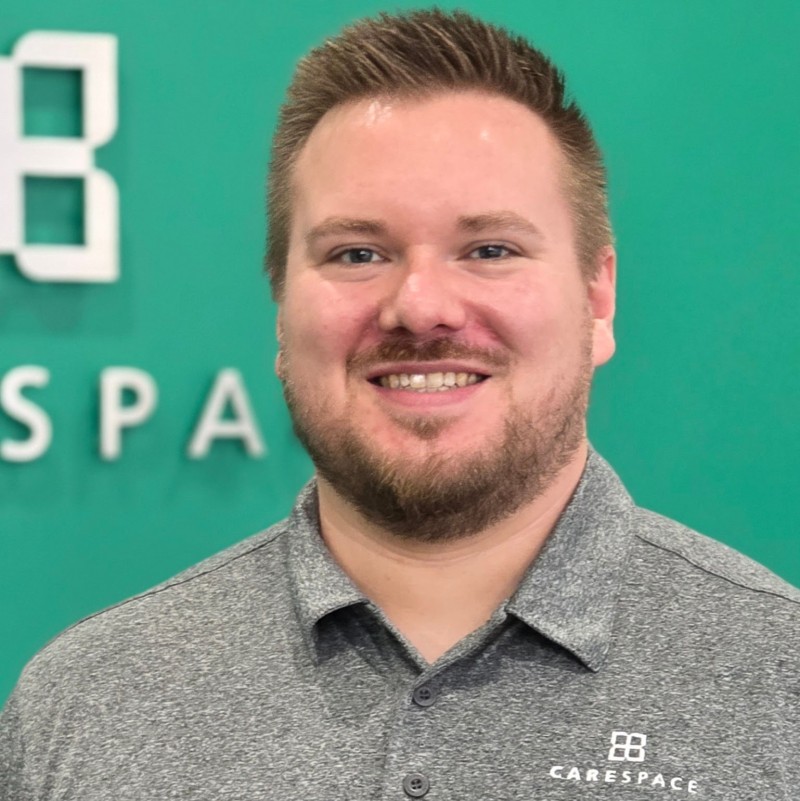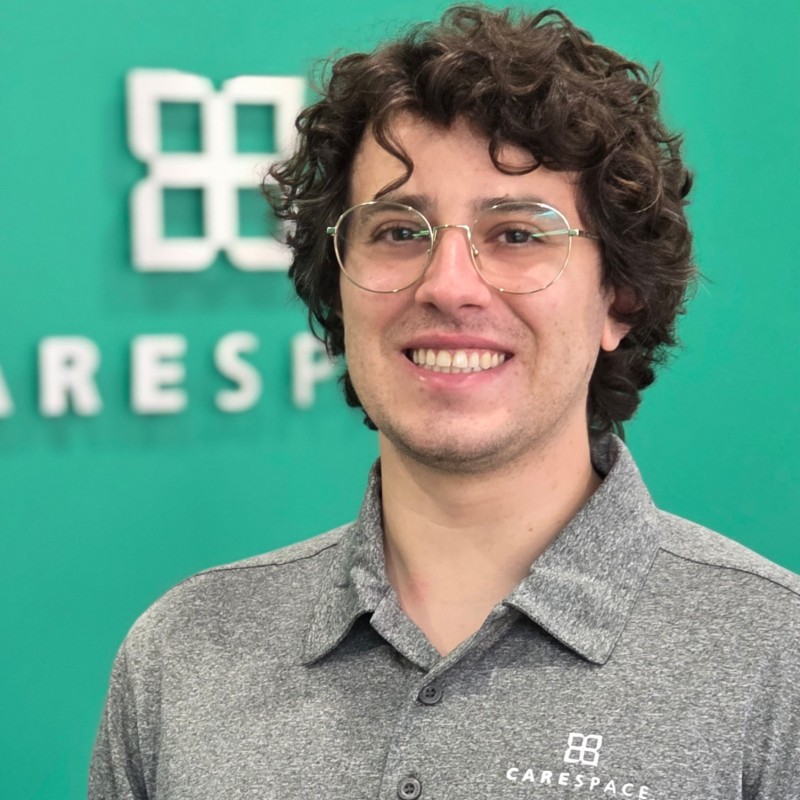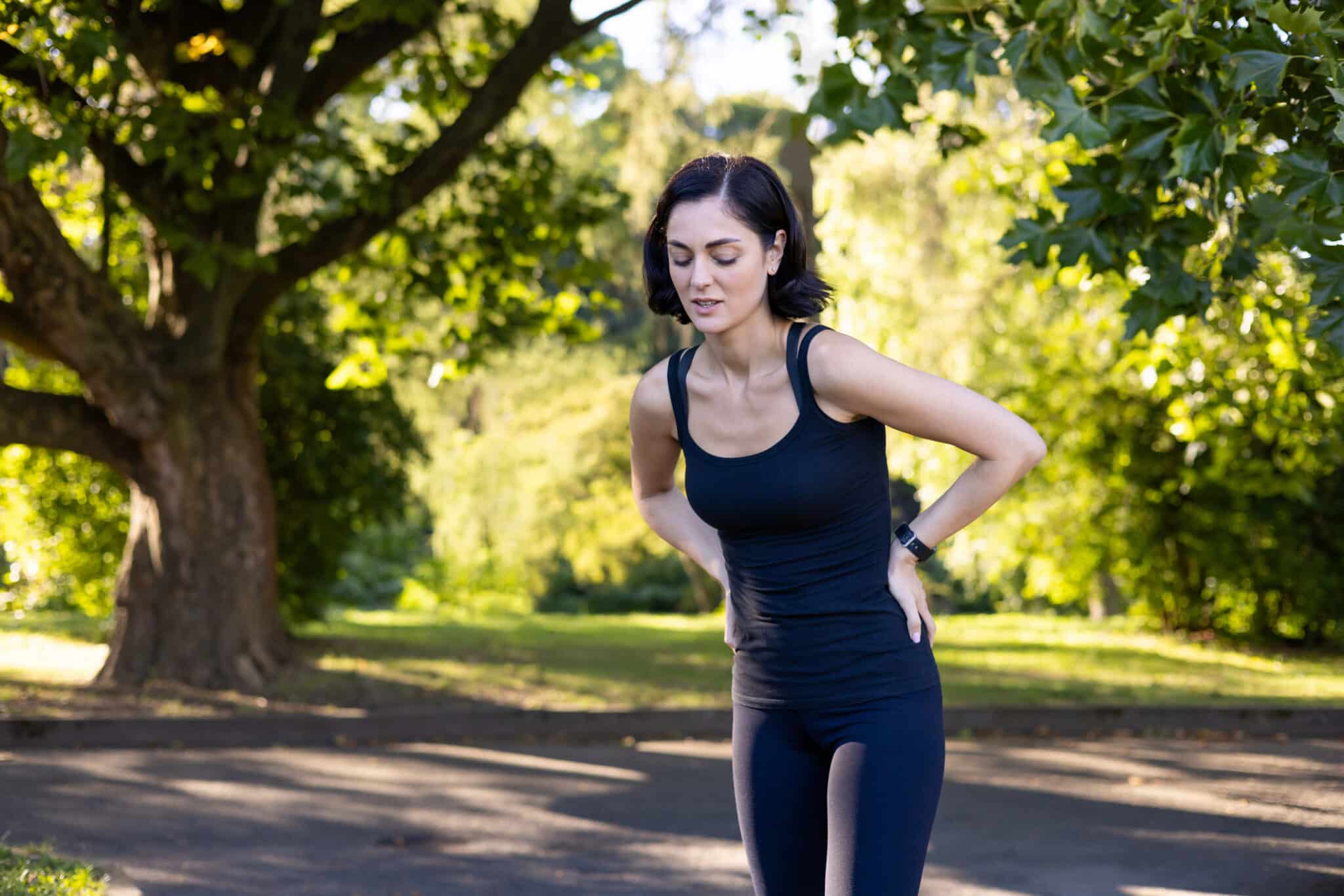
Osteopath
Client-focused osteopathic care to help you move better, recover faster, and live healthier.
Appointments available now – call (519) 208-2273 or book online today!
Open 7–days a week!
Monday–Friday: 8 AM–8 PM
Saturday–Sunday: 8 AM–6 PM
Choose a location:
→ Osteopath in Kitchener
→ Osteopath in Waterloo
→ Osteopath in Cambridge
Evidence-Based Osteopathic Care at CARESPACE

Select an Osteopath
Ready to start? Book your first appointment by choosing an osteopath from our CARESPACE team.
Osteopathy is a client-centred discipline of manual medicine that focuses on the intricate relationship between the body’s structure and its overall function. It is a holistic approach that uses a deep understanding of anatomy and physiology to assess and treat the root cause of your pain and dysfunction, not just the symptoms. At CARESPACE, our Osteopathic Manual Practitioners use an evidence-based, multidisciplinary approach to help restore motion, improve circulation, and support your body’s inherent ability to heal.
Book an appointment online or call today to begin your journey to recovery and wellness.
Why Choose CARESPACE for Osteopathy?
Choosing a healthcare provider is a significant decision, especially in a field like manual osteopathy where the quality of training and care can vary. At CARESPACE, our approach is built on a foundation of integration, evidence, and personalization, providing a client experience that is comprehensive, effective, and worthy of your trust.
- Integrated, Coordinated Care: Your body is an interconnected system, and your healthcare should be too. Our Osteopathic Manual Practitioners are a key part of a multidisciplinary team, collaborating directly with physiotherapists, chiropractors, massage therapists, and other specialists under one roof. This means your care is never siloed; your entire health team works together on a unified plan, leading to more comprehensive and lasting results.
- Evidence-Based Treatments: The practice of osteopathy at CARESPACE is grounded in both foundational principles and modern scientific research. Our practitioners apply techniques and protocols that are supported by clinical studies for their effectiveness in treating conditions like chronic low back pain, neck pain, and headaches. We move beyond tradition alone to provide advice and treatment you can trust.
- Personalized to Your Goals: Every treatment plan begins with listening. We take the time to understand your unique health history, lifestyle, and what you want to achieve. Whether your goal is to find relief from chronic pain, recover from a complex injury, or simply improve your overall function and well-being, your osteopathic care plan is tailored specifically to you.
- Accessible and Convenient: We make it easy to access the expert care you need. With multiple clinic locations and simple online booking, you can schedule appointments that fit your life. We provide a detailed receipt after each visit for easy and convenient self-submission for payment from your insurance provider, allowing you to focus on your health.
See our Osteopathic Manual Practitioners and start your personalized plan today.
Thousands of people have chosen CARESPACE for osteopaths that deliver real results.
Google Reviews for Osteopaths at CARESPACE
How Osteopathy Helps You Be Your Best
Osteopathy is a profound and gentle approach to health that empowers you to overcome physical limitations and live a fuller, more active life. By focusing on the principle that the body is a self-healing unit and that structure governs function, an Osteopathic Manual Practitioner can help you resolve long-standing issues, recover from setbacks, and unlock your body’s true potential for health and vitality.
Finding the Root Cause of Pain and Discomfort
Chronic pain—whether it’s in your back, neck, hips, or manifesting as persistent headaches—can be debilitating and frustrating, especially when other treatments have only provided temporary relief. Osteopathy excels at looking beyond the site of pain to find the underlying cause. Your pain might be in your shoulder, but the root cause could be a restriction in your ribs, a strain pattern in your diaphragm, or an old ankle injury that changed the way you walk. An Osteopathic Manual Practitioner uses highly refined palpation skills to assess the entire body, identifying these subtle restrictions in joints, muscles, fascia, and even organs. By treating the root cause, osteopathic care aims not just to silence the symptom, but to resolve the underlying dysfunction, leading to more profound and lasting relief.
Accelerating Recovery After Injury or Surgery
When you experience an injury or undergo surgery, the body’s natural response is to protect the affected area. This often leads to muscle guarding, stiffness, and the development of compensatory movement patterns that can persist long after the initial injury has healed. These compensations can lead to new problems down the road. Osteopathic manual practice plays a crucial role in the recovery process by gently restoring mobility, improving circulation and lymphatic drainage to the injured area, and releasing compensatory strain patterns throughout the body. This holistic approach ensures that you not only heal from the injury but also restore balanced, efficient movement, reducing the risk of re-injury and helping you return to your activities with confidence.
Preventing Future Issues and Building Long-Term Wellness
Many of the aches and pains we accept as “normal” are the cumulative result of years of poor posture, repetitive movements, or unresolved minor injuries. Osteopathy is a powerful tool for prevention and long-term wellness because it can identify and address these subtle imbalances before they become significant problems. By assessing the body as a whole, an Osteopathic Manual Practitioner can find areas of restricted mobility or tissue tension that may not be symptomatic yet but are forcing other parts of your body to work harder. By gently restoring balance and improving the body’s overall mechanics, regular osteopathic care can help prevent the onset of chronic pain, improve your posture, increase your resilience to stress and injury, and support healthy aging.
Enhancing Performance in Sport and Life
Optimal performance, whether in athletics or daily life, requires the body to function as a seamless, integrated unit. Any restriction in movement—in a joint, a muscle, or the fascia that connects everything—can create a drag on the entire system, limiting your power, efficiency, and coordination. Osteopathy can help enhance performance by fine-tuning your body’s mechanics. An Osteopathic Manual Practitioner can identify and release these subtle restrictions, ensuring that your joints move freely, your muscles fire in the correct sequence, and your body can transmit forces efficiently. This can lead to improved athletic performance, reduced risk of injury, and a greater sense of ease and freedom in all your movements, allowing you to enjoy your favorite activities to the fullest.
What Is Osteopathy?
Osteopathy is a system of manual medicine based on the philosophy that the body functions as an integrated unit, possesses an inherent ability to heal, and that its structure and function are reciprocally interrelated. It is a patient-centred discipline that uses a wide range of gentle, hands-on techniques to diagnose and treat restrictions in the body’s tissues to restore health. However, understanding osteopathy in Ontario requires navigating some important distinctions regarding titles and regulation.
Osteopath vs. Osteopathic Manual Practitioner in Ontario
In Ontario, the landscape of osteopathy can be confusing for the public. It is critical to understand the two distinct types of practitioners:
- Osteopathic Physicians (D.O. or “Osteopath”): In Ontario, the title “Osteopath” is a legally protected title under the Medicine Act, 1991. It can only be used by Osteopathic Physicians who have graduated from an accredited osteopathic medical school in the United States. These individuals are fully licensed medical doctors, registered with the College of Physicians and Surgeons of Ontario (CPSO). They have the full scope of practice of a medical doctor, including the ability to prescribe medication and perform surgery. There are very few practicing Osteopathic Physicians in Ontario.
- Osteopathic Manual Practitioners (OMP): This is the title used by the vast majority of osteopathic practitioners in Ontario and across Canada. These practitioners are specialists in manual therapy and are not medical doctors. Their practice is focused exclusively on using manual techniques for assessment and treatment, and they do not prescribe drugs or perform surgery. The practitioners at CARESPACE are Osteopathic Manual Practitioners.
The State of Regulation in Ontario
Currently, the practice of manual osteopathy is not a regulated health profession in Ontario under the Regulated Health Professions Act, 1991. This means there is no government-mandated college overseeing the profession, and training standards can vary significantly between educational institutions.
Because of this lack of government regulation, reputable professional associations have been established to create and uphold high standards for education and practice to protect the public. Organizations like the Ontario Association of Osteopathic Manual Practitioners (OAO) and Osteopathy Canada (OSTCAN) have set rigorous educational benchmarks, often based on the World Health Organization’s guidelines, which include a minimum of 4200 hours of education and 1000 hours of supervised clinical training. When choosing an Osteopathic Manual Practitioner, it is crucial to ensure they are a member of a reputable association like the OAO or OSTCAN, as this indicates they have met these high standards.
The Core Principles of Osteopathic Philosophy
Osteopathic practice is guided by four foundational principles established by its founder, Dr. Andrew Taylor Still. These principles form the lens through which an Osteopathic Manual Practitioner views health and disease:
- The Body is a Unit; the Person is a Unit of Body, Mind, and Spirit: This principle recognizes that the human body is an integrated whole. No part functions in isolation. A problem in one area of the body can have far-reaching effects on other areas. This holistic view means the practitioner considers the entire person—their physical structure, physiological processes, and mental-emotional state—in the assessment and treatment.
- The Body is Capable of Self-Regulation, Self-Healing, and Health Maintenance: Osteopathy is founded on the belief in the body’s innate wisdom and its powerful, inherent capacity to heal and maintain health. The role of the practitioner is not to “fix” the body, but to facilitate this natural healing process by removing obstructions and restoring normal function.
- Structure and Function are Reciprocally Interrelated: This is the cornerstone of osteopathic thought. It means that the structure of the body (bones, muscles, ligaments, organs, etc.) has a direct impact on its function, and conversely, the way the body functions affects its structure. A restriction in a joint (structure) will impair its movement (function). Repetitive poor movement (function) can lead to changes in the tissues (structure). An OMP uses this principle to understand how dysfunction in one area can lead to symptoms in another.
- Rational Treatment is Based Upon an Understanding of the Basic Principles of Body Unity, Self-Regulation, and the Interrelationship of Structure and Function: This principle ties the others together. An effective treatment plan is not based on a generic protocol for a condition, but on a rational application of the first three principles to the unique individual. The goal is to find the root cause of the dysfunction and apply the most appropriate manual techniques to help the body restore its own health.
The Osteopathic Manual Practitioner’s Toolkit
An Osteopathic Manual Practitioner uses a wide variety of gentle, hands-on techniques. Their primary diagnostic tool is their highly trained sense of touch, or palpation, which they use to feel for subtle changes in the quality, texture, and mobility of the body’s tissues. Treatment is always tailored to the individual. Some of the common techniques include:
- Soft Tissue Manipulation: This includes a range of techniques like stretching, kneading, and deep pressure to relax tense muscles, release fascial restrictions, and improve circulation to the tissues.
- Myofascial Release: This technique involves applying gentle, sustained pressure to the fascia—the web of connective tissue that surrounds and connects every muscle, bone, nerve, and organ in the body. Releasing restrictions in the fascia can relieve pain and restore mobility across the entire body.
- Muscle Energy Technique (MET): This is an active technique where the patient is asked to gently contract a specific muscle against the practitioner’s counter-pressure. This is used to lengthen shortened muscles, improve joint mobility, and reduce localized tissue restriction.
- Articulatory Techniques: These involve gentle, rhythmic movements of a joint through its full range of motion. The goal is to improve the quality of movement within the joint, encourage the production of synovial fluid (the joint’s natural lubricant), and improve circulation.
- Strain-Counterstrain: This is a gentle, indirect technique where the practitioner finds a tender point in a muscle and then moves the body into a position of maximum comfort to release the muscle spasm and “reset” the nerve signals that are keeping the muscle tight.
- Visceral Manipulation: This involves gentle manual techniques applied to the organs (viscera) of the body to improve their mobility, tone, and motion. The theory is that organs, like joints, can become restricted, and that these restrictions can cause both local and referred pain patterns.
- Cranial Osteopathy: This is a very subtle and gentle technique that involves the practitioner placing their hands on the patient’s head to feel for and influence the subtle, rhythmic motion present in all body tissues, known as the primary respiratory mechanism. It is used to treat a wide range of conditions, from headaches and TMJ dysfunction to concussions and sinus issues.
Not sure if osteopathy is right for you? Book a free discovery call today.
When to Consider Osteopathy
Because of its holistic, whole-body approach, osteopathic manual practice can be beneficial for a wide array of health concerns, from common aches and pains to more complex chronic conditions. It can be used as a primary treatment or as a complement to other therapies like physiotherapy or chiropractic care.
Consider booking an osteopathic assessment if you are experiencing:
- Persistent Musculoskeletal Pain: Chronic low back pain, neck pain, shoulder pain, or hip pain that hasn’t responded to other treatments. Osteopathy is particularly effective at finding the hidden root causes of these persistent issues.
- Recurring Headaches and Migraines: Headaches that are related to neck tension, jaw issues (TMJ), or postural strain. Cranial osteopathy can be especially helpful for these conditions.
- Digestive Issues: Functional digestive problems like bloating, constipation, or acid reflux, where visceral manipulation can help improve organ mobility and function.
- Post-Injury or Post-Surgical Recovery: Lingering pain, stiffness, or restricted movement after an injury or surgery, even long after the initial healing period is over. Osteopathy can help release scar tissue and compensatory strain patterns.
- Postural Problems: Discomfort and pain related to long hours of sitting, repetitive work tasks, or postural habits. Osteopathy can help restore balance to the body and provide education on improving ergonomics.
- Pregnancy and Postpartum-Related Pain: Back pain, pelvic pain, and other discomforts that arise during pregnancy or after childbirth. The gentle techniques used in osteopathy are safe and effective during this time.
- Issues in Babies and Children: Common infant issues like feeding difficulties, colic, or plagiocephaly (flat head syndrome), where gentle cranial osteopathy can be beneficial.
- General Stiffness and Reduced Mobility: A feeling that your body is “getting old” and stiff. Osteopathy can help restore mobility and improve your overall sense of well-being and ease of movement.
Book an assessment today and get clear answers about your health.
The CARESPACE Difference: A Higher Standard of Osteopathic Care
At CARESPACE, osteopathic manual practice is not just a standalone treatment; it is an integral part of a comprehensive and collaborative approach to healthcare. This philosophy elevates the standard of care, ensuring that your treatment is not only effective for your immediate symptoms but also aligned with your overall health and wellness goals.
Evidence-Based Practice in Action
Our commitment to being evidence-based means your care is informed by both the foundational principles of osteopathy and the most current and reliable scientific research. Our Osteopathic Manual Practitioners continuously review new studies and clinical guidelines, such as systematic reviews on the effectiveness of osteopathic manipulative treatment (OMT) for conditions like low back pain, to refine their techniques and treatment protocols. This ensures that the care you receive is supported by a solid foundation of modern evidence for its safety and effectiveness.
Multidisciplinary Coordinated Care
The true power of the CARESPACE model lies in collaboration. Imagine you are seeing an Osteopathic Manual Practitioner for chronic hip pain. They identify a restriction in your pelvis and a fascial pull through your abdomen. After your session, they can walk down the hall and consult directly with your physiotherapist. They can discuss their findings and align the osteopathic treatment with the specific strengthening and motor control exercises you are performing, ensuring both therapies are working in synergy to address both the structural and functional aspects of your problem. This seamless communication eliminates guesswork and accelerates your path to recovery.
Personalized, Client-Focused Plans
There is no one-size-fits-all approach to health. Your journey at CARESPACE begins with a comprehensive assessment where your practitioner listens to understand your unique situation, your health history, and what matters most to you. Your osteopathic treatment plan is then designed specifically to meet those needs and goals. We track your progress, adapt the plan as you improve, and ensure you are an active partner in your own care every step of the way.
Accessible and Convenient
We believe that accessing high-quality healthcare should be simple and stress-free. Our clinics are designed to be welcoming and efficient, with easy online booking that puts you in control of your schedule. We provide a detailed receipt after each visit for easy and convenient self-submission for payment from your insurance provider. For those who need it, we also provide virtual consultations through our TeleCARE platform, making expert guidance accessible from anywhere.
Insurance Coverage
Because osteopathic manual practice at CARESPACE is performed by practitioners who are members of reputable professional associations like the OAO or OSTCAN, these services are covered by most extended health insurance plans. We can help you understand your coverage and will provide all necessary documentation for reimbursement, making it easy to invest in your health.
A Results-Driven Approach
Our ultimate goal is to help you achieve tangible, meaningful results. We focus on measurable improvements in your pain levels, mobility, function, and overall well-being. By combining evidence-based osteopathic care with a collaborative care model, we are dedicated to helping you not just feel better, but to truly be your best.
Osteopathy Conditions Treated
- Back Pain
- Neck Pain
- Headaches and Migraines
- Sciatica
- Joint Pain (Shoulder, Hip, Knee)
- Arthritis
- Chronic Pain
- Sports Injuries
- Repetitive Strain Injuries (RSI)
- Postural Issues
- TMJ Dysfunction (Jaw Pain)
- Digestive Issues
- Pregnancy-Related Pain
- Post-Concussion Syndrome
Osteopathy Frequently Asked Questions (FAQs)
What is the difference between an Osteopath and an Osteopathic Manual Practitioner in Ontario?
Is manual osteopathy regulated in Ontario?
Does osteopathic treatment hurt?
What is the difference between osteopathy and chiropractic?
What is the difference between osteopathy and physiotherapy?
How many sessions will I need?
Is osteopathy covered by insurance?
Do I need a doctor's referral?
Meet Our Osteopathic Manual Practitioners
Osteopath
Fitness Trainer/FST, Assistant Director
Waterloo - Uptown Waterloo
Please call us at (519) 208-2273 or book online today.
CARESPACE Locations Offering Osteopathy

Live-answer Reception
Please call us at (519) 208-2273 to talk with our live-answer Reception Team who will be happy to book, reschedule appointments or answer any of your questions, or book online now.
Open 7-days a week!
Monday–Friday: 8 AM–8 PM
Saturday–Sunday: 8 AM–6 PM
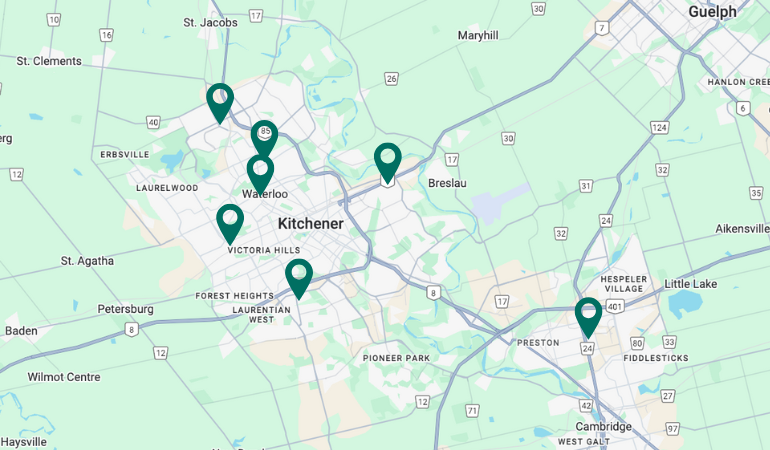
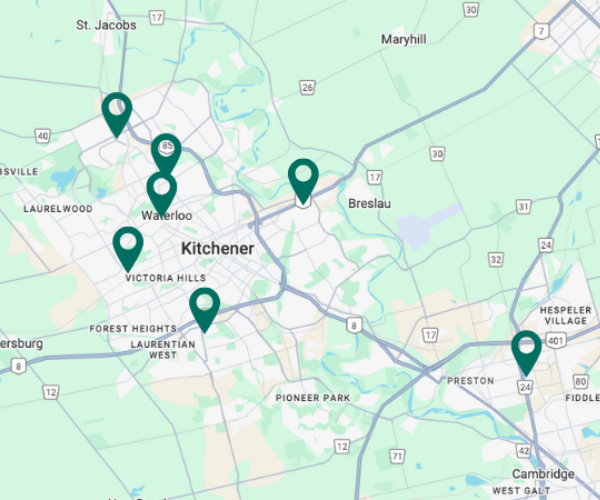
CARESPACE Hespeler Road
529 Hespeler Road, Cambridge, ON N1R 6J2
What to Expect at Your First Osteopathy Visit
Your first osteopathy visit at CARESPACE is a comprehensive and deeply investigative experience designed to understand your unique health story and get to the root cause of your concerns. We prioritize listening and clear communication to ensure you feel comfortable, informed, and confident in your care.
- A Thorough Conversation (The Health History): The visit begins with you. Your Osteopathic Manual Practitioner will dedicate a significant amount of time to an in-depth conversation about your primary health concerns, but also about your overall health history. This includes past injuries, surgeries, illnesses, and even major life stressors, from childhood to the present day. This detailed history is crucial, as an old, forgotten injury could be the root cause of your current problem.
- A Comprehensive Assessment (The Body Scan): Next, your practitioner will conduct a detailed physical assessment. You may be asked to stand and perform some simple movements to observe your posture and how your body moves as a whole. The majority of the assessment will be hands-on, with you lying on the treatment table. Using their highly trained sense of touch (palpation), your practitioner will gently assess the mobility and quality of the tissues throughout your entire body—from your feet to your head—including joints, muscles, fascia, and organs.
- A Clear Explanation (The Osteopathic Perspective): Based on the findings from your history and assessment, your practitioner will discuss their osteopathic hypothesis with you in clear, easy-to-understand language. They will explain how different areas of restriction and strain patterns in your body are interconnected and contributing to your symptoms. This is a collaborative process, and you will have ample opportunity to ask questions and ensure you are comfortable with the proposed plan.
- Your First Treatment: Your first treatment will begin during this initial visit. Using a variety of gentle, hands-on techniques tailored to what your body needs, the practitioner will start to address the most significant restrictions found during the assessment. The goal is to gently encourage the body to release tension, restore mobility, and begin its natural healing process.
- A Plan for the Future: You will leave your first appointment with a clear understanding of your personalized care plan. This includes the recommended frequency of follow-up visits and any simple advice on movement or self-care to support the treatment and help you maintain the improvements between sessions.
Insurance & Payment
Osteopathic manual practice is covered by most extended health plans in Ontario, provided the practitioner is a member of a recognized professional association. At CARESPACE, we make the process simple by providing a detailed receipt after every appointment. This receipt contains all the necessary information for you to easily submit a claim to your insurance provider for reimbursement. No physician referral is required to begin care, and our pricing is transparent. We are committed to making high-quality osteopathic care accessible.
Osteopathy vs. Other Approaches
Navigating the options for manual therapy can be confusing. Understanding the unique focus of osteopathy compared to physiotherapy, chiropractic, and massage therapy can help you make an informed choice. At CARESPACE, we believe the best approach often involves a combination of these disciplines, working in synergy.
Osteopathy vs. Physiotherapy
The primary distinction lies in the philosophical approach and scope of assessment. Physiotherapy is a health profession that excels at rehabilitating injuries and restoring function to a specific area of the body, primarily using therapeutic exercise, education, and targeted manual therapy. Osteopathy, guided by its core principles, takes a whole-body approach to every problem. An Osteopathic Manual Practitioner assesses the entire structure to find the root cause of dysfunction, which may be far from the area of pain, and uses a wide range of gentle manual techniques to restore the body’s self-healing capacity.
Osteopathy vs. Chiropractic Care
While both professions use manual techniques to address joint restrictions, their focus and methods differ. Chiropractic care primarily focuses on the health of the spine and its relationship with the nervous system. The main therapeutic tool is the spinal adjustment, which is typically a high-velocity, low-amplitude (HVLA) thrust designed to restore motion to a specific spinal joint. Osteopathic manual practice uses a much broader range of techniques, most of which are gentle and do not involve HVLA thrusts. The assessment and treatment extend beyond the spine to include the entire musculoskeletal system, as well as the fascia, organs (viscera), and the craniosacral system.
Osteopathy vs. Massage Therapy
The key difference is one of assessment and intent. Registered Massage Therapy is highly effective for assessing and treating the body’s soft tissues—muscles, tendons, ligaments, and fascia—to relieve pain, reduce muscle tension, and improve circulation. Osteopathy is a system of manual medicine that involves a comprehensive assessment of the entire body to form an osteopathic hypothesis about the root cause of a patient’s symptoms. While OMPs use soft tissue techniques, their treatment is guided by this whole-body diagnosis and also includes work on joints, ligaments, organs, and the craniosacral system to address the underlying dysfunction.
The CARESPACE Difference: Why an Integrated Approach is Best
You do not have to choose. The core philosophy at CARESPACE is that the best outcomes are achieved when different therapeutic approaches work together. Your team of health professionals collaborates to determine the optimal combination of treatments for your specific needs. Your plan might include osteopathy to address the underlying structural imbalances, physiotherapy to restore strength and proper movement patterns, and massage therapy to manage compensatory muscle tension. This integrated, client-focused model ensures you receive the most comprehensive and effective care possible.
Osteopathy Evidence & Outcomes
At CARESPACE, our commitment to evidence-based care means we rely on high-quality scientific research to guide our practice. While the body of evidence for manual osteopathy is still growing, numerous systematic reviews and clinical trials have investigated the effectiveness of osteopathic manipulative treatment (OMT) for a range of conditions.
Low Back Pain
Low back pain is one of the most studied areas in osteopathic medicine. A systematic review and meta-analysis of randomized controlled trials published in 2005 concluded that OMT significantly reduces low back pain, with a level of pain reduction greater than expected from placebo effects alone that persists for at least three months. More recent Cochrane reviews looking at spinal manipulative therapy (which includes techniques used by osteopaths) have found it to be as effective as other recommended therapies like exercise and physiotherapy for chronic low back pain.
Neck Pain
The evidence for OMT in treating neck pain is also promising. A 2021 single-blinded randomized controlled trial found that OMT is relatively safe and effective in reducing pain and disability in patients with chronic neck pain. The study also reported significant improvements in sleep, fatigue, and depression, highlighting the holistic benefits of the treatment. An overview of systematic reviews also found promising evidence for the effectiveness of OMT for musculoskeletal disorders, including chronic non-specific neck pain.
Headaches
For primary headaches, such as migraines and tension-type headaches, the evidence is still developing but shows potential. A 2017 systematic review concluded that there is a preliminary low level of evidence that OMT is effective in the management of headache, noting that it could likely reduce the number of episodes per month as well as drug use. The gentle, holistic approach of osteopathy, particularly cranial osteopathy, makes it a compelling option for individuals seeking non-pharmacological solutions for headaches.
Safety and Risk Profile
Osteopathic manual practice is widely regarded as a safe and gentle form of manual therapy. The techniques used are non-invasive and are adapted to the individual patient’s age, health, and specific needs. The most common side effects are mild and transient, such as temporary soreness or stiffness for a day or two after treatment. Serious adverse events are exceedingly rare when treatment is provided by a properly trained practitioner who is a member of a reputable professional association that upholds high standards of practice and safety.
Latest Insights on Osteopathic Care and Wellness
Explore more expert tips and insights on how osteopaths can support your mobility, recovery, and overall wellness. See all osteopathy articles.
Ready to find the root cause of your pain and feel your best?
Take the first step toward achieving your health goals. Our team of Osteopathic Manual Practitioners is here to listen to your story and create a personalized plan to help you manage pain, restore mobility, and improve your overall vitality. Book your appointment online in seconds and begin your journey to being your best.

